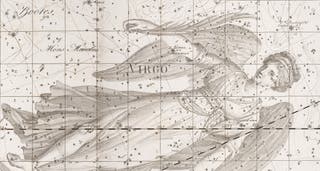Flamsteed, John. Atlas celeste. Lisbon, 1804.
After Flamsteed’s atlas had gone through two French and two German editions, it appeared in Portuguese in 1804. This atlas is quite rare. The plates are copies of those in the 1795 edition of Lalande, but all of the identifying labels are in Portuguese, so Auriga is identified as “o Cocheiro”, and Lepus has become “A Lebre”. The Gemini plate is here reproduced in full below, so one can see the coordinates scales on the borders, and the star magnitude key at the bottom. The “Grand telescope of Herschel,” just above the Twins, commemorates the telescope with which Herschel discovered thousands of nebulae, none of which are depicted in any of the Flamsteed atlases.
If we compare the Canis Major region from the Portuguese edition (below left) with its counterpart from the 1795 Lalande edition (below right), we see that, although the language of the identifying labels has changed, the positions of the stars and nebulae are identical.

